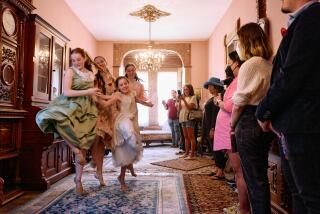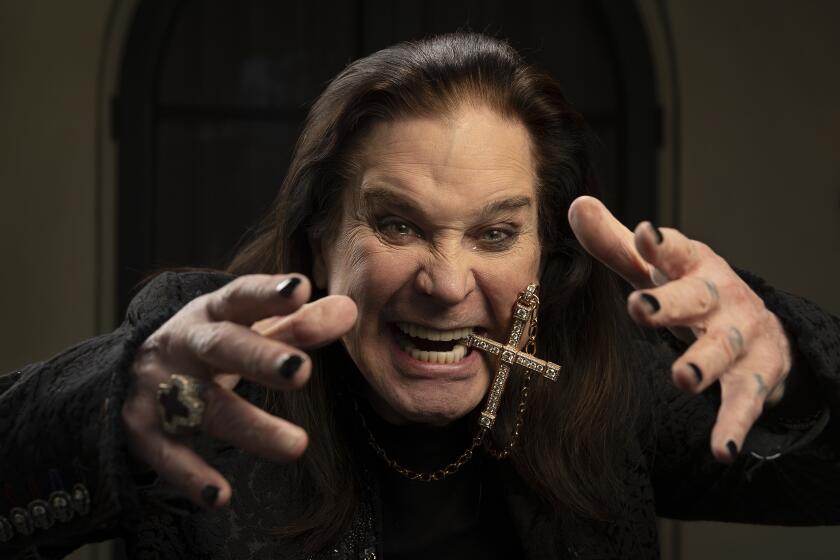OC LIVE! : Ballet Folklorico: Influence From Beyond Americas the Beautiful
- Share via
As Ballet Folklorico de Mexico’s general manager, Salvador Lopez devotes his days to preserving the past. Sacred Aztec ritual, village fiestas, revolution-era Mexico, such is the substance of his 9 to 5.
When he’s off work, he proudly perpetuates the Mexican tradition of charriada (rodeo), riding and roping in the fashion of his forefathers.
But what did he rush to do when he got the Folklorico job a dozen years ago? Modernize. He bought the troupe its first computer and fax machine.
“There was nothing here,” Lopez recalled, “so I renovated.”
The high-tech shopping spree was the beginning of an administrative tuneup that troupe officials agree has helped Ballet Folklorico make it to the age of 43. With many folkloric companies threatened by falling governments and economic woes, that’s no small feat.
These days, sellout crowds are also tough to come by, but the 65-member troupe of musicians and dancers filled the 3,000-seat Orange County Performing Arts Center with whooping, whistling fans when it last visited Costa Mesa in 1992. It returns this weekend, in a joint presentation of the Philharmonic Society of Orange County and the center, to launch an 18-city tour of western states. (It performs at Universal Amphitheatre Sept. 15 and 16.)
Long an official cultural representative of Mexico, the troupe founded by Amalia Hernandez has spawned imitators aplenty, north and south of the border.
It delivers beautifully costumed dance spectacles that travel back in time (as far back as the Olmec Indians, believed to be the Americas’ earliest civilization, existing 3,000 years ago), celebrate Mexico’s varied regional festivals and showcase the country’s rich ethnic mix with exuberant dances influenced by European, African, Middle Eastern, Asian and other cultures.
“Yucatan: Danzon and Jarana,” a West Coast premiere, blends Mayan tradition, stately 17th- and 18th-Century Spanish dance and sensual Caribbean rhythms.
Lopez, 35, will perform the company’s enduring rope dance, executing charriada rope tricks he’s honed over the past two decades.
“We consider the rope dance an art in Mexico,” he said in a recent phone interview from Folklorico’s Mexico City headquarters. “It’s very technical, but it’s also something like the bullfight: If you do it slow and you transmit that emotion to the public, then you can make the people watching get involved in the art and your dynamic.”
Lopez’s grandmother--founder Hernandez--is well known for her indomitable dynamism, which more than anything else explains the troupe’s longevity. At 78 she continues to choreograph and travel with the company--although she recently slipped, breaking her nose and a bone in her wrist, and couldn’t attend a Los Angeles press conference. In some ways, she has maintained tight control over operations. She has personally groomed Lopez, her daughter Norma Lopez Hernandez, who runs the company’s resident troupe, and other assistants. She’s Ballet Folklorico’s sole choreographer--having crafted some 45 works--and until recently was its only spokesperson. Lopez, however, has found her generally open to change in his dozen years as general manager.
“Amalia has accepted everything I suggested that I thought would help the company,” he said.
The company had no system of telephone ticket sales; Lopez fixed that. It had ended a 20-year tradition of U.S. tours when famed impresario Sol Hurok, who had arranged the visits, died in 1979; under Lopez, new co-producers were hired--Adam Friedson of Los Angeles and Julio Solorzano of Mexico City--and the tours resumed.
Lopez also “renovated the image” of Ballet Folklorico, he said, with new, more aggressive marketing techniques aimed at Mexico City tourists. This has helped raise domestic ticket sales even as the company has had to cancel concerts in the country’s provinces, he said, where economics have kept people at home.
Future projects for Ballet Folklorico include a Christmas program celebrating varied Nativity traditions throughout Mexico, Lopez said. The project, envisioned as an equivalent to ballet’s lucrative “Nutcracker,” may debut as early as next year.
A loftier, longer-term goal involves opening schools of Mexican folk culture, from dancing to cooking, “around Mexico and maybe around the world,” Lopez said. The possibility of such an academy in Los Angeles is being explored.
(BEGIN TEXT OF INFOBOX / INFOGRAPHIC)
* What: Ballet Folklorico de Mexico.
* When: Saturday, 8 p.m.; Sunday, 3 p.m.
* Where: Orange County Performing Arts Center, 600 Town Center Drive, Costa Mesa.
* Whereabouts: San Diego (405) Freeway to Bristol Avenue exit north. Turn right from Bristol onto Town Center Drive.
* Wherewithal: $10 to $37.
* Where to call: (714) 556-2787.
More to Read
The biggest entertainment stories
Get our big stories about Hollywood, film, television, music, arts, culture and more right in your inbox as soon as they publish.
You may occasionally receive promotional content from the Los Angeles Times.










